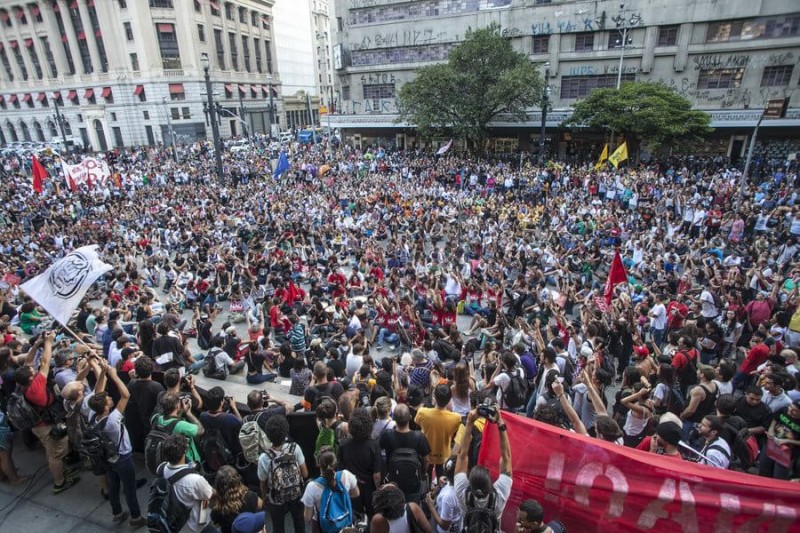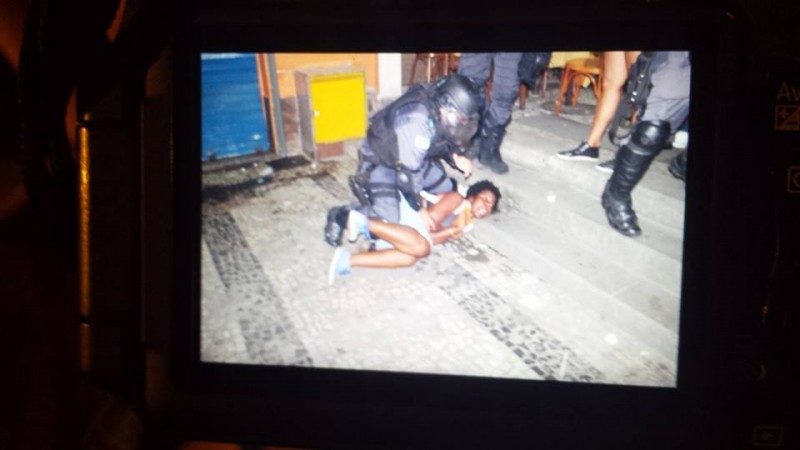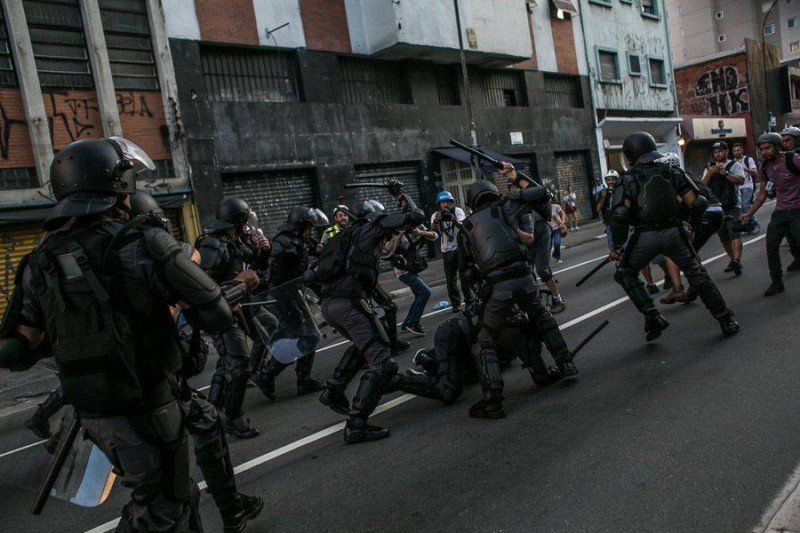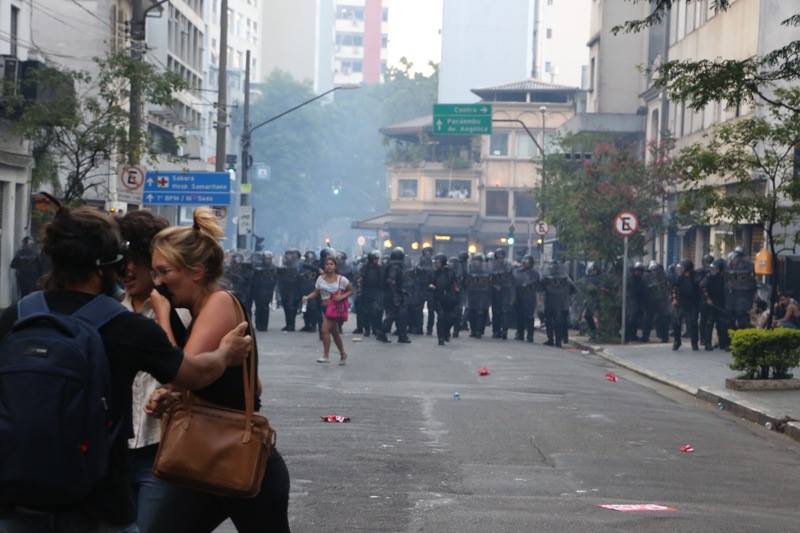
Demonstration in the center of São Paulo. Image: Midia Ninja, CC BY-2.0
Brazil was swept into an unprecedented wave of protests in 2013 against a hike in public transportation fares. Millions of people took to the streets in June of that year, and their numbers grew as police reacted with increasing violence.
The police repression, rather than cooling the tempers of the protesters, only fostered an even more radical opposition. The first Black Blocs appeared and protests continued at least up until and during the World Cup the following year. Police were accused of brutally suppressing peaceful demonstrations as a way to reinforce their own strength, and their actions ended up provoking an equally violent response from those in the streets.
The demonstrations, despite their size, won little more than empty promises from the federal government and a freeze on the bus fares — which now seems to have come to an end. After a truce and a lull in protests during the recent elections, in which President Dilma Rousseff was reelected by a small margin, the protests have returned with renewed strength after the announcement of a new hike in bus tickets, trains and subway fares.

Police detain a young black woman in Rio de Janeiro. Image: Collective Olhar Independente, free use.
Ticket prices already increased in Belo Horizonte, Fortaleza and Florianopolis in December. In Rio de Janeiro, São Paulo and Salvador, they rose in early 2015.
In São Paulo and Rio, tickets increased by 50 and 40 cents respectively. In Belo Horizonte, it was 25 cents, but the increase was later suspended by a state court. In order to calm the protests, São Paulo Mayor Fernando Haddad announced a free pass for poor and public school students, a decision criticized by the Free Pass Movement (MPL), who considered the measure insufficient since the free pass would only be for students going home from school and back, and would not change the exclusion other social groups face in regards to public transportation.
Demonstrations were called to 7 January in several cities such as Belo Horizonte and Rio de Janeiro. In Rio, almost 5,000 people gathered for the rally, during which the Collective Olhar Independente says it documented an assault against a protester:
Thamires Fortunato, estudante de filosofia da UFF é arrastada pelos cabelos e detida no QG da PM na Rua Evaristo da Veiga e não é permitido o acesso da advogada ativista Cristiano Oliveira do DDH. PM diz que ela será conduzida para a 17° DP em São Cristóvão.
Thamires Fortunato, a philosophy student at UFF, is dragged by the hair and held at the Military Police (PM) Headquarters on Evaristo da Veiga Street and is not allowed access activist lawyer Cristiano Oliveira from [NGO] Human Rights Advocates. PM says she will be conducted for 17° DP [Police Office] in the neighborhood of São Cristóvão.
According to the movement, 30,000 people attended the protest in São Paulo, while the estimate of the military police was 5,000. Demonstrators reported being beaten by police officers as they walked on the streets.
Video recorded by YouTube user Karashh shows the moment when the police began to attack the demonstrators:
According to a witness, a small group of Black Blocs knocked over some trash cans and hit the iron doors of closed shops. Journalist Eliane Brum reported a bank branch in the region was also vandalized by this small group. It was enough for the police to start throwing tear gas and firing rubber bullets — which in 2013 blinded a photographer and injured a female journalist in the eye – to disperse the protest, which from the beginning was tense given the official statements of the military police command saying they would not allow the march to happen.
Pablo Ortellado, a professor who was at the demonstration, criticized the media coverage and accused the police of starting the violence:
Sou testemunha ocular de que a PM, depois de um incidente isolado na Paulista, atacou gratuitamente uma gigantesca manifestação que transcorria pacifica na Consolação. O MPL foi informado de que haviam acontecido prisões na Paulista, segurou a manifestação na Consolação até a situação se acalmar e a enorme passeata, de dezenas de milhares de pessoas, que estava noutra rua e a cem metros do incidente foi gratuita e covardemente atacada pela polícia. Não obstante, a imprensa, de maneira unânime, relatou o episódio como uma reação da polícia a vandalismo dos manifestantes. Uma narrativa que simplesmente mistura espaços geográficos e inverte a ordem dos fatos.
I am an eyewitness that the military police, after an isolated incident on Paulista [avenue], attacked a massive non-violent protest that peacefully walked down Consolação [street]. The Free Fare Movement was informed of the arrests on Paulista, and so held the demonstration on Consolação until the situation became more calm, and the huge march of tens of thousands of people, who were on another street and a hundred yards away from the incident, were cowardly attacked by police anyway. Nevertheless, the press unanimously reported the episode as a police response to vandalism by the protesters. A narrative that simply mixes up the geographic areas and reverses the order of events.

A demonstrator on the ground is attacked by half a dozen police officers. The activist Bruno Bonsanti (@brunobonsanti) described the photo: “Who started the violence? Demonstrators or the military police? Fuck it: five police officers beating an already subdued man. That's the problem.” Photo: Mídia Ninja, CC-BY 2.0
Some sources report that protesters threw stones at the police. Journalist Leonardo Sakamoto, who was at the rally, wrote on his Facebook page:
Um pequeno grupo provocou os policiais, espalhou lixo e bateu nas portas das lojas. Eles, que teoricamente deveriam ser treinados para reagir de forma controlada nessas situações, responderam com gás lacrimogêneo, bombas de efeito moral e balas de borracha, atingindo e dispersando a manifestação – que seguia pacífica – e assustando pessoas que nem participavam da marcha. Não vou dizer que não mudou nada de 2013 para cá porque, pelo jeito, estão com estoque renovado desses armamentos.
A small group provoked the police, spread garbage and hit the doors of shops. The police, which theoretically should be trained to react in a controlled manner in these situations, responded with tear gas, stun grenades and rubber bullets, hitting and dispersing the demonstrators — who were peaceful — scaring people who weren't even taking part in it. I will not say that nothing has changed since 2013 because it seems that they have a renewed stock of those weapons.
The demonstration began a little after 17h without incident, marching out of the city center towards Paulista Avenue, São Paulo's main thoroughfare. Before reaching the avenue, however, the police attacked, splitting the demonstration in two and charging at both ends.
Free Fare Movement's profile on Facebook summarized the violence and added:
Com a brutal repressão policial, os governos deixam sua resposta à justa reivindicação da população que luta contra o aumento do preço da tarifa. Longe de discutir a revogação dos aumentos que decretaram, Alckmin e Haddad respondem só com violência: tiros, bombas e prisões contra quem se manifesta.
Through brutal police repression, the government has given its answer to a fair demand from the population, who fights against the fare increase. Far from discussing the suspension of the increases they have ruled, Alckmin and Haddad only answer with violence: shots, bombs and arrests against those who speak out.
Spanish journalist Bernardo Gutierrez denounced the provocation and subsequent repression of the police on Twitter:
Eu estava no protesto #contratarifa em Sao paulo. (I) a PM ficou provocando durante o protesto todo, com a técnica do envelope e agressivos — Bernardo Gutiérrez (@bernardosampa) 9 janeiro 2015
(II) como jornalista fui desrespeitado pela PM. PM lançou bombas de efeito moral e gás lacrimogêneo sem motivo, contra os manifestantes — Bernardo Gutiérrez (@bernardosampa) 9 janeiro 2015
(III) A PM parecia ter ordens para impedir a chegada do protesto #contratarifa na Av Paulista. Tinha muita gente:entre 10 e 15.000 pessoas — Bernardo Gutiérrez (@bernardosampa) 9 janeiro 2015
I was in the #contratarifa [against the tariff] protest in São Paulo. (I) the military police were provoking a response throughout the protest, by Kettling and [by being] aggressive
(II) as a journalist I was disrespected by the military police. They launched stun grenades and tear gas for no reason against protesters
(III) The military police seemed to have orders to prevent the arrival of the #contratarifa protest on Avenida Paulista. There were a lot of people: from 10 to 15,000 people
Small groups of protesters who were dispersed moved into the surrounding areas and were pursued by police. At least 32 demonstrators were arrested, while Ortellado, the professor, reported that 38 were detained. At the end of the night, the police reported that the number was more than 50.
At least five people were injured and taken to hospitals. Some of the wounded treated on the street can be seen in this video. Some tear gas bombs thrown by the police ended up in a subway station.
Activist and journalist Lucas Moraes wrote on his Facebook page:
51 presos em São Paulo por protestarem contra os aumentos das tarifas de ônibus. Se você acha que já passamos de junho de 2013, feliz ano velho! Que os movimentos sociais se preparem para enfrentar o modus operandi que os governos buscam perpetuar por meio de suas polícias militares. E preparem igualmente os seus pulmões para respirar muito gás lacrimogêneo vencido.
51 arrested in São Paulo for protesting against the increase in bus fares. If you think we've already been through June 2013, happy old year! May social movements prepare themselves to face the modus operandi that governments seek to perpetuate through their military polices. And may they also prepare their lungs to breathe a lot of expired tear gas.
The Homeless Workers Movement (MTST), one of the most powerful social movements in Brazil, made clear their rejection of the police violence commanded by São Paulo governor Geraldo Alckmin and announced they will participate in future events:
ALCKMIN NÃO APRENDEU COM 2013! PM do Governo Alckmin reprime brutalmente Ato contra o aumento da tarifa em São Paulo. Em 2013 isso massificou as mobilizações. Alckmin quer repetir a dose? O MTST irá às ruas contra este ataque!
ALCKMIN DIDN'T LEARN WITH 2013! Alckmin's military police brutally repressed a demonstration against the fare hike in São Paulo. In 2013 this only fed the rallies. Alckmin wants to repeat the dose? The MTST will go to the streets against this attack!
Fabio Malini, a professor and activist, published on Facebook a graphical analysis of almost 30,000 tweets about the protests. 2013 seems to be repeating itself: the alliance between Alckmin and Haddad to jointly increase ticket prices in defiance of popular opinion, police violence, and sectors of the media supporting repression, calling protesters “vandals” and underestimating the size of the demonstration. A new protest is called for next Friday, January 16.








5 comments